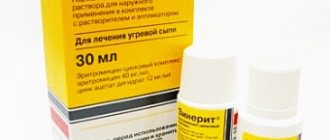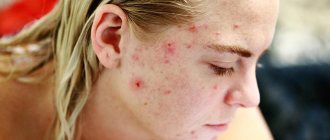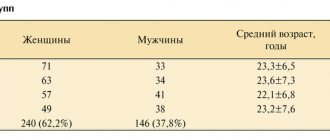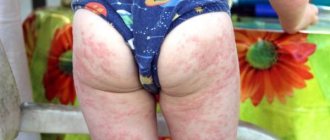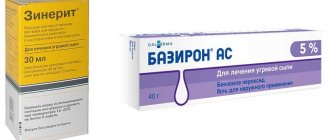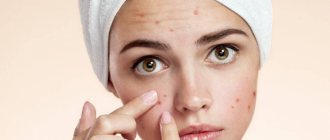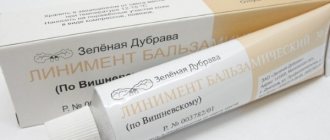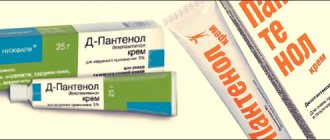From this article you will learn:
- drug Zenerit – composition, analogues,
- detailed instructions for use,
- reviews of Zinerit from dermatologists.
Zineryt for acne (Zineryt) is an antibacterial drug in the form of a solution for external use, containing the antibiotic erythromycin + zinc acetate complex. The drug is used to treat papulopustular acne (pimples). It is produced in the Netherlands, but the trademark on Zineryt® already belongs to (Denmark).
Zinerit is available in pharmacies without a doctor's prescription. It can be used in adults and children over 12 years of age. The antibiotic erythromycin is a long-known macrolide antibiotic and has been used to treat acne for more than half a century. This is due to its high activity against the bacteria Propionibacterium acnes and Streptococcus epidermidis, which are involved in the development of acne.
Reviews of the drug Zinerit from dermatologists have always been good, until recently, but recently there have been many reports of increasingly frequent cases of resistance of Propionibacterium acnes bacteria to macrolide antibiotics (according to the most authoritative textbook on dermatology, Fitzpatrick's Dermatology). Exactly the same data is reflected in many monographs and scientific works of Russian doctors.
How much does Zinerit cost in pharmacies:
The price for the drug Zinerit in pharmacies starts from 587 rubles (the price is indicated for 2022). Moreover, this is significantly lower than just a few years ago. Of course, the reason for this is the smaller number of prescriptions of this drug by dermatologists to their patients with acne. However, the drug cannot be considered completely irrelevant.
Indications for use –
The Zinerit instruction contains only 1 indication for the use of the drug - this is “acne treatment”. But in fact, this requires an important explanation, because... The instructions are written frankly illiterately. With acne, we have only non-inflammatory elements - these are either whiteheads (closed comedones) or blackheads (open comedones). Antibiotics are generally not used to treat non-inflammatory elements of acne.
Antibiotics are needed to treat specifically the papulopustular form of acne (pimples). It is in this case that we have inflammatory elements - papules and/or pustules, which we will treat with antibiotics. In addition, we will use topical antibiotics only for papulopustular acne of mild or moderate severity, because in severe cases, antibiotics are prescribed only orally (in tablets).
Klindovit
Manufacturer: JSC AKRIKHIN (Russia)
Release form: gel for external use
Active ingredient: clindamycin
Clindovit belongs to the group of lincosamide antibiotics, which is active against bacteria that cause acne. The Russian analogue of Zinerit effectively eliminates inflammatory processes on the skin. Stopping the vital activity of pathogenic microflora occurs by suppressing the synthesis of protein compounds in the microbial pathogen, which leads to cleansing of the skin.
Zenerit: composition and release form
Zinerit instructions for use tell us that the packaging of the drug consists of 2 bottles, as well as an applicator for applying the drug. The bottles must be mixed immediately before the 1st use. Keep in mind that after mixing the components of the drug, the finished solution can be stored (at a temperature of 15° to 25°C) and used for no more than 5 weeks.
Composition of bottles 1 and 2 –
| Bottle No. 1 (dry mixture): antibiotic erythromycin - 1.2 g, zinc acetate - 360 mg. |
| Bottle No. 2 (solvent): ethanol – 17.1 ml, diisopropyl sebacate – 7.8 ml. |
After diluting the dry mixture, we get 30 ml of the finished solution. Thus, the content of active components in 1.0 ml of solution will be –
- antibiotic erythromycin – 40 mg,
- zinc acetate – 12 mg,
- ethanol – 0.55 g,
- diisopropyl sebacate – 0.25 g.
→ Zinerit instructions for use (official, in FDF format)
Composition analysis –
Erythromycin belongs to the macrolide group of antibiotics. This antibiotic is especially effective against the bacteria Propionibacterium acnes and Streptococcus epidermidis, which play an important role in the development of inflammation and the formation of acne (papules and pustules). It should be noted that after application, only a very small part of erythromycin enters the systemic circulation (24stoma.ru).
Zinc helps reduce the production of sebaceous gland secretions (sebum), and also increases the sensitivity of pathogenic bacteria to erythromycin. In general, the addition of zinc to the composition allowed the manufacturer to reduce the number of cases of the formation of resistance of Propionibacterium acnes bacteria to erythromycin. Nevertheless, statistics clearly indicate that cases of resistance to erythromycin (even with zinc) are much more common than cases of resistance to drugs based on the antibiotic clindamycin.
pharmachologic effect
Manufacturer: ASTELLAS PHARMA EUROPE B.V. (Netherlands)
Release form: powder for the preparation of a solution for external use
Active ingredients: zinc acetate, erythromycin
Analogues: Baziron, Zerkalin, Skinoren
Zenerit is an erythromycin-zinc complex that has a pronounced anti-inflammatory, antimicrobial, comedolytic effect. The mechanism of action of the drug is aimed at blocking the biochemical processes of protein compounds in the microbial pathogen that provokes the formation of acne.
The active ingredients in the composition of the drug Zinerit cause inhibition of bacterial growth and a decrease in the production of sebaceous gland secretions due to the astringent effect of the active component of the medication.
How to use Zenerit: instructions
The drug is used 2 times a day: in the morning (necessarily before applying makeup) and in the evening after washing before bed. The course of treatment is 10-12 weeks (however, good results are achieved after 2 weeks of using the drug). The rest of the time is necessary to consolidate the results of therapy.
Preparation and use of the drug –
The contents of the solvent bottle must be completely poured into the dry powder bottle. After this, the bottle must be shaken until the powder is completely dissolved in the solvent. After this, the bottle can be closed with a lid with an applicator.
What does the Zinerit applicator look like:
Step-by-step instructions: 1) The packaging of the drug contains two bottles and one applicator. 2) First, open the caps of both bottles, keeping the cap of bottle A containing the powder. 3) The solvent from bottle B must be poured into bottle A with powder. 4) Close bottle A (with powder and solvent) with a cap. 5) Shake bottle A for 1 minute. 6) Remove the cap from bottle A and attach the applicator to the bottle. 7) Push the cap that contains the applicator into the full bottle and close tightly. Open the cap of the bottle and check that the applicator is securely attached. 9) Write the date of mixing the drug on the bottle (the prepared solution can be used within 5 weeks).
Open the cap of the bottle and check that the applicator is securely attached. 9) Write the date of mixing the drug on the bottle (the prepared solution can be used within 5 weeks).
To apply the drug, you need to tilt the bottle with the applicator down. The pressure applied controls the speed at which the solution is applied to the skin. The solution is colorless and therefore will not be noticeable after drying. The drug is intended for external use only (for application to the skin).
Zinerit: reviews from a dermatologist
On the drug Zinerit for acne - reviews from dermatologists and researchers at medical universities increasingly boil down to the fact that every year more and more strains of the bacteria Propionibacterium acnes are discovered that are insensitive to this drug. The reason for this is largely due to the over-the-counter availability of the drug (this means the possibility of advertising on TV), which potentiates the uncontrolled use of this drug by patients - as a means of self-treating acne at home.
You may suspect Propionibacterium acnes bacteria are resistant to Zinerit if you do not notice an effect from therapy within 2 weeks of use. The downside is the possibility of developing cross-resistance - when the development of resistance to erythromycin can automatically lead to microflora resistance to other antibiotics, for example, clindamycin.
There is a large list of scientific papers on Propionibacterium acnes resistance to erythromycin. For example, Barinova A.N. “Modern methods of treatment and rehabilitation of patients with acne vulgaris” (Federal State Budgetary Educational Institution of Higher Education “North-Western State Medical University named after Mechnikov” of the Ministry of Health of Russia, St. Petersburg). We quote: “The use of erythromycin is currently limited due to the large number of resistant strains of Propionibacterium acnes.” And there are a lot of studies with the same conclusions.
Important: In addition, we do not recommend using this medication for patients with dry or sensitive skin. The drug contains ethyl alcohol as a solvent, therefore we will get even more drying of the skin. The drug is better suited for patients with oily skin.
Zinerit: analogues of the drug
An analogue of Zenerit for acne is cheaper - this is a drug from the Russian pharmaceutical company Arpimed, which produces a similar product - “2% erythromycin solution” for external use. However, this solution has only a 2% concentration of erythromycin, which corresponds to a dosage of 20 mg per 1 ml (this is 2 times lower than in the drug Zinerit), and in addition, the drug does not contain zinc. Accordingly, all this will mean a very rapid development of bacterial resistance to erythromycin.
Side effects -
In some cases, slight redness, dryness and flaking of the skin, tingling or burning may occur at the site of use of the drug. Such effects are normal and do not require discontinuation of the drug.
Contraindications for use –
You should not use Zinerit if you have a hypersensitivity (allergy) to erythromycin or other macrolide antibiotics, as well as to zinc or other components of the drug.
Use during pregnancy and breastfeeding –
The use of the drug during breastfeeding and pregnancy is possible if the recommended dosage of application is observed (no more than 0.5 ml per 1 application). The safety of the drug is due to the fact that erythromycin practically does not penetrate the skin and does not enter the systemic bloodstream. Studies have not revealed a negative effect of the drug on the fetus.
Zinerit means for the treatment of acne and subcutaneous rashes
Perhaps this is the product with the most controversial reviews. Some people adore it and recommend it to everyone, others complain that it dries out the skin wildly and it almost peels off after using it. 
I decided to write a more or less objective review, and also give advice on HOW to use this product. Since most negative results come from inept use.
So, at the moment I have ideal facial skin. This is without any exaggeration; the only disadvantages include uneven color and temporary redness, but this can easily be solved with the right skincare products. I have no acne, no pimples, no blackheads, or just small subcutaneous pimples.
This is without any exaggeration; the only disadvantages include uneven color and temporary redness, but this can easily be solved with the right skincare products. I have no acne, no pimples, no blackheads, or just small subcutaneous pimples.
And few would believe that at the age of 15-16 I had the whole “bouquet” of the nasty things listed above. The following entered the fight: “talk” according to a super prescription from a pharmacy, salicylic ointment, alcohol-containing products, drugs like Darsonval, stimulating masks, etc. But I couldn’t really cleanse my face - the situation was improving, but I could only dream of smooth skin.
In the end, I MYSELF, through trial and error, selected a set of tools for myself that were incredibly effective and helped me get to where I am now.
Among them: clay masks, levomekol, badyaga, clay-based scrubs, tar soap and the like.
But I consider Zinerit an indispensable remedy. Moreover, the current state of my facial skin is 75% thanks to him.
So, the remedy Zinerit for the treatment of acne and subcutaneous rashes .
It consists of two jars, one of which contains liquid, the other contains powder. Mixing all this, we get a very thermonuclear mixture, but at the same time effective.
And just because of the powerful effect, coupled with illiterate use, it is easy for them not only to dry out the skin, but even to cause the opposite effect - the appearance of acne.
Therefore, below are some facts and recommendations, the assimilation of which will help avoid negative consequences:
1) Zenerite dries out the skin. And this is NOT a drawback, because skin inflammations (which are pimples and blackheads) must be treated with drying agents.
What to do?
Under no circumstances should you smear the product all over your face if the inflammation, for example, is only on the forehead. Otherwise, you will heal your forehead, but in addition you will get dry and flaky cheeks. This mistake, by the way, is the reason for many denials. reviews: “Ahhh, my skin almost peeled off after this, it dried it out so much!” Naturally, only the “user” is to blame here.
Apply Zenerite every now and then. Also, do not be overzealous and smear yourself with it every 4 hours. The ideal application scheme is below.
By the way, some write that Zenerit, on the contrary, overfat the skin of the face. This, of course, is nonsense. It has an oily texture, but it has a drying effect on the skin and nothing else. If after consuming Zenerit your skin becomes more oily, look for the reasons in your diet, skincare products, hormones, but not in it.
2) Zenerit is a very fatty product. Having smeared your face with Zenerite, you will look like a shiny pig. Therefore, for me personally, it is akin to suicide that some girls smear themselves with Zenerite in the morning, and then apply makeup ON TOP, along with foundation, powder, etc. Under no circumstances should you do this! This entails not only a disgusting appearance, but also problems such as...
3) Clogged pores. Zinerite lies quite tightly on the skin, so if you smear any cosmetics (especially foundation) on top, your pores will be blocked from accessing the “world” for a long time. And clogged pores, along with any pollution, lead to the appearance of acne. Do you understand, right? By placing a mixture of Zenerite and cosmetics on your face, you will only cause the opposite effect and God knows what will happen to your face.
I heard that some doctors recommend applying Zenerit in the morning under cosmetics. I would sincerely hit them in the forehead with Zenerite.
4) By the way, Zenerite can easily dry out not only clean skin, but also inflamed skin. That is, the pimple will go away, but instead there will be an area of flaking, dryness and irritation. This is easy to avoid. You just have to use it like this:
Application:
In the evening, thoroughly cleanse your face. No creams, tonics, etc. - the skin should be clean. I washed my face with tar soap to dry my skin additionally. Next, apply Zenerite to the inflamed areas. Let's go to bed.
In the morning, thoroughly cleanse your face again) Now you can wipe your skin with an antibacterial tonic. BE SURE to moisturize your skin! Some thick nourishing cream. Ideally, “winter” - as it retains moisture in the upper layers of the skin. Apply makeup and do everything as usual)
In the evening - Zenerit again. Those. This product is applied AT NIGHT and the skin must be moisturized with cream in the morning. Follow this and there will be no overdrying.
5) Zenerite has a wildly bitter taste. Therefore, immediately tell your loved one that when you have this “muck” on your face, kissing on the cheek is prohibited. In general, after applying it, it is advisable to immediately go to bed, because in the summer it is hot in Zenerit =D And also touch your face less. More precisely, do not touch your face with your hands at all. And in the future too - this contributes to micropollution, which also leads to clogging of pores)
6) Don't forget to scrub and exfoliate your skin between uses. Only already healed pimples, not fresh ones. After the pimple is squeezed out, the edges of the skin remain as if “torn”, so after inflammation dried with Zinerite, peels remain, which are easily removed with a scrub. And their appearance is normal. But if the pimple was not squeezed out, then Zinerit leaves nothing at all after it, no pockmarks, no spots.
Only already healed pimples, not fresh ones. After the pimple is squeezed out, the edges of the skin remain as if “torn”, so after inflammation dried with Zinerite, peels remain, which are easily removed with a scrub. And their appearance is normal. But if the pimple was not squeezed out, then Zinerit leaves nothing at all after it, no pockmarks, no spots.
7) And lastly: Zenerite is an excellent remedy for solving temporary problems. Even if you have more or less clear skin, but a treacherous beast still jumps out a couple of times a month, Zenerite will “kill” it in a day or two. In fact, I still have a jar “just in case.”
Result:
I destroyed the “ecological disaster” on my face in three months. I mean, completely, that is, when there were no longer any spots or bumps. Perfectly smooth skin.
And now I’ve been living peacefully for 5 years now and I always recommend Zinerit to those who have problems with their face, because for me, having tried many products, it turned out to be simply unsurpassed.
It’s a pity that there is no “BEFORE” photo.. But the “After” facial skin looks like this:
Without Photoshop and foundation There is only a veil of bronzer on the face. So viva la Zenerit!
There is only a veil of bronzer on the face. So viva la Zenerit!
I recommend reading the large post “How to get problem skin in order in a short time” and the review “Pharmacy external remedies for acne - experience of use.”
Thank you for your attention!
Zenerit or Baziron: which is better?
Baziron contains a highly effective bactericidal component for the treatment of acne, such as benzoyl peroxide. To date, there are no strains of bacteria that are resistant to benzoyl peroxide and are associated with the development of acne. But the choice between these drugs is not as simple as it seems - it all depends on the type of inflammatory elements.
Let us remind you that acne can be in the form of papules or pustules (with pus). If you mainly have only papules that do not contain pus, it is optimal to use a combination of “benzoyl peroxide + topical retinoid” (for example, Baziron + Clenzit). If you have acne in the form of pustules with pus, then you need a combination of “benzoyl peroxide + antibiotic + topical retinoid”. These are the treatment protocols that are professional, and you can familiarize yourself with them using the link below.
Why is it important to give benzoyl peroxide along with an antibiotic for pustules? Studies have shown that in this case, not only the effectiveness of therapy increases, but also the risk of the bacteria Propionibacterium acnes developing resistance to the antibiotic is sharply reduced.
→ International acne treatment protocols → International acne treatment protocols
Which is better: Skinoren or Zenerit
Skinoren belongs to the group of drugs based on azelaic acid. Drugs in this group are used to treat acne, and not to treat papulopustular acne (pimples). In turn, antibacterial drugs are used only to treat either acne or nodules. Therefore, it is simply pointless to compare the effectiveness of these drugs - each of them is designed to treat different forms of acne. We hope that our article on the topic: Does Zinerit help with acne was useful to you!
Sources:
1. Textbook of dermatology “Fitzpatrick's Dermatology” (8th edition), 2. “Modern methods of treatment and rehabilitation of patients with acne vulgaris” (Barinova), 3. “Acne from the position of evidence-based medicine” (Anisimova), 4. “Cellular mechanisms of barrier protective functions of the skin and their disorders in skin diseases” (Medelets).
How does Zinerit work?
The combination of zinc salt and erythromycin provides strong activity against various infectious pathogens that provoke the development of acne:
- against epidermal streptococcus;
- propionibacterium acne.
The antibiotic suppresses the proliferation of pathogenic bacteria, promoting their death. Zinc has an astringent and antiseptic effect, dries out rashes, reduces inflammatory reactions, forms a thin protective film on the surface, and accelerates cell regeneration. Zinerite helps cleanse pores of impurities and accumulations of sebum clots, facilitates the removal of excess secretions, and prevents the progression of acne and its relapses.
When applied topically, the drug is almost not absorbed orally; the mixture of its components forms tight compounds with biological components, unable to penetrate the bloodstream. Microscopic doses of Erythromycin may appear in the body, but do not lead to further resistance of the opportunistic microflora of the body to antibiotics of this group.
